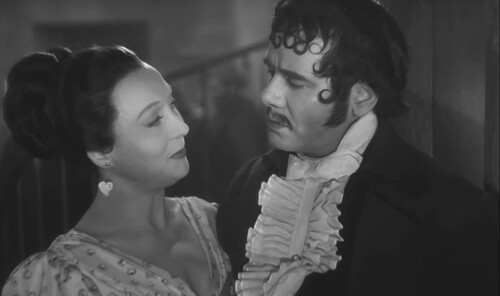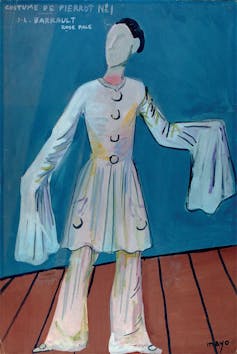How to republish
Read the original article and consult terms of republication.
“Les Enfants du paradis”: 80th anniversary! A look back at Carné and Prévert’s masterpiece
By Carole Aurouet, University Professor of Cinema and Audiovisual Studies, Université Gustave Eiffel.

Delayed until the Liberation, so that it could be shown to a French public freed from Nazi occupation, the release of the film Les Enfants du paradis (“Children of Paradise”) struck a chord with those who had lived through the Second World War. With UNESCO World Heritage classification, the film by Marcel Carné and Jacques Prévert is celebrating its 80th anniversary this year. A look back at the origins of this cinema classic.
Eighty years ago, Les Enfants du paradis was released in cinemas. The film, directed by Marcel Carné and written by Jacques Prévert, had a chaotic genesis. After Jenny (1936), Drôle de drame (“Bizarre, Bizarre”, 1937), Le Quai des brumes (“Port of Shadows”, 1938), Le Jour se Lève (“Daybreak”, 1939) and Les Visiteurs du soir (“The Devil’s Envoys”, 1942), the famous French film duo created a cinematic miracle in liberated France. Conceived in a country that the occupying forces wanted to silence, the film came about thanks to the solidarity and tenacity of an exceptional team, proclaiming love and freedom loud and clear.
A poetic ode to love and freedom
The main theme of the film is thwarted love. A liberty-loving courtesan, Garance (Arletty), is the catalyst for the love and affection of four distinct suitors: Baptiste’s (Jean-Louis Barrault) is intense and dreamy, Frédérick Lemaître’s (Pierre Brasseur) is sensual and all talk, Lacenaire’s (Marcel Herrand) is more cerebral, the Count of Montray’s (Louis Salou) is mercenary. Only Garance and Baptiste’s love is true and reciprocal. Their relationship provides the main plotline, around which the other love interests unfold, serving as subplots.
This is one of Prévert’s distinctive screenwriting techniques: inventing peripheral plots and multiple secondary characters in order to create a wealth of roles for his actor friends. With this approach in mind, when he began a script, he first created the protagonists: he took a huge sheet of paper and drew horizontal lines on it, like a musical stave, on which he arranged them from most important to least important. At the bottom of the page, he added street musicians and singers or flower sellers, as additional minor roles for his friends. Each protagonist was defined by words and drawings. From this initial creative stage, snippets of dialogue that would ultimately be heard in the film began to emerge. This was the case with “Claire comme le jour, Claire comme de l’eau de roche” (“Clear as day, Clear as spring water”), the words used to describe Garance.
The main strength of the screenplay lies in the density of its dramatic structure. The proliferation of subplots gives the story its power, and the central theme of love allows the film to address the question of individual freedom and the ability to break free from social constraints. What is also striking is the presence of emancipated female characters. Garance and Nathalie (Maria Casarès) are indeed different from most female characters in films at that time, who were often confined to roles that served to highlight the men.
Finally, Prévert’s dialogues hit home; they work on an emotional level, with an apparent simplicity that is nevertheless very difficult to achieve. They come from the heart and go straight to the heart, and are spoken using “everyday words”, to use Garance’s expression.
The images invented by Carné are born from these finely crafted, poetic dialogues and serve to enhance the words. The director conceived each shot in harmony with the dialogue. He also had a gift for crowd scenes, and the movement he brought to them. In addition, he excelled at alternating between wide shots and close-ups of faces, often from the front, laying bare the characters’ loneliness.
A film made during the war
The actor Jean-Louis Barrault, who joined the Comédie-Française in 1940, where his productions of Phèdre (1942) and Le Soulier de satin (“The Satin Slipper” ) (1943) were a resounding success, provided the spark that ignited Les Enfants du paradis. With their previous film, Les Visiteurs du soir (“The Devil’s Envoys”) (1942), Carné and Prévert had taken refuge in the Middle Ages to avoid Vichy censorship, and made their mark with a final scene showing an indomitable heart continuing to beat beneath the stone.
In 1942, Carné and Prévert were in Nice seeking a new subject for a film – a task complicated by the Occupation – when they came across their friend Barrault on the Promenade des Anglais. The actor, who was fascinated with the life of Deburau, the famous mime artist from the 1830s and, in turn, with Frédérick Lemaître, a contemporary actor in spoken theatre, told his comrades that the mime artist had, with his cane, beaten to death a man who had insulted his companion, and that all members of Parisian society had flocked to his trial to hear him speak!
Carné was enthusiastic about the idea of making a film about the Boulevard du Temple and its multitude of theatres. As for Prévert, he was enamoured with a character who was more or less a contemporary of Deburau: Lacenaire, a murderous poet, public scribe, swindler and an anarchist dandy before his time, a man who claimed to be a victim of humanity's injustice and who had declared war on society. The screenwriter immediately saw an opportunity that was too good to miss: “They won't let me make a film about Lacenaire, but I can put Lacenaire in a film about Deburau.”
Prévert, the set designer Alexandre Trauner, the composer Joseph Kosma and the costume designer Mayo set about their tasks in an isolated Provençal farmhouse near Tourrettes-sur-Loup (Alpes-Maritimes). The documentation required for the project came mainly from the Musée Carnavalet, and was brought by Carné. In addition to period engravings, the sources were also textual, mainly the Histoire du Théâtre à Quatre Sous, Pour Faire Suite à l’Histoire du Théâtre-Français (1881), by Jules Janin.

The set became a sort of commune where Trauner and Kosma, who were Jewish and therefore not allowed to work, were hidden and worked clandestinely, thanks to the courageous and active solidarity of Carné and Prévert.
It took six months to write the film. This was the first time Prévert had written an original screenplay on his own. Filming began on 16 August 1943 and ended on 15 November 1944. It was marred by various events: violent storms that destroyed the sets at the Victorine studios in Nice, restrictions imposed by the Occupation, bombing during scenes shot in Paris, a shortage of film that had to be bought on the black market, and the arrest of members of the Resistance who were involved in the filming.
A lasting cinematic legacy
The release of Les Enfants du paradis was delayed until after the Liberation so that it could be shown to audiences in a France freed from Nazi occupation. The story of Baptiste, a lonely lover thrown into the absurdity of a hostile world, struck a chord with audiences who had lived through the Second World War. In 1945, 428,738 people went to see it. Fifty years later, the film still makes a lasting impression on viewers. In 1995, it was voted the best film of the first century of cinema and, in the same year, it was awarded UNESCO World Heritage status.
Les Enfants du paradis had a massive impact on many creative artists. It is true that the film pays tribute to silent films rather than talkies, using mime and, by extension, referencing silent cinema. When studying Prévert’s first draft of the script, one can make out ‘Buster Keaton’ in the line describing Baptiste and also notice a drawing of the Lumière brothers.
It would be impossible to list here all the artists who have been influenced by the film, so let’s mention just three of them, chosen at random. In 1984, the filmmaker François Truffaut said: “I’ve made twenty-three films (exactly the same number as Carné), some good, some not so good. Well, I would forfeit them all, without exception, to have made Les Enfants du paradis. In 2016, French-Chilean director Alejandro Jodorowsky paid a charming tribute to the iconic carnival scene in Les Enfants du paradis in his film Poesía sin fin. In 2020, in his autobiography Échappées belles, actor Denis Lavant evoked the importance of “the demonstration through gesture”, of “this silent plea” that he had “memorised by heart. The ideal beauty of an art that would serve to restore the truth...” and concluded:
“You will understand that Les Enfants du paradis inspires me at every level; for me, it is a source of inspiration for acting, for life, for poetry ”.
A masterpiece of poetry, freedom and humanity, Les Enfants du paradis breathed new life into its era and continues to do so today. ![]()
Identity card of the article
Original title: | 80 bougies pour « Les Enfants du paradis » ! Retour sur le chef-d’œuvre de Carné et Prévert |
Author: | Carole Aurouet |
Publisher: | The Conversation France |
Collection: | The Conversation France |
Licence: | This article is republished from The Conversation France under Creative Commons licence. Read the original article. An English version was created for Université Gustave Eiffel and was published by Reflexscience under the same license. |
Date: | July 18, 2025 |
Languages: | French and English |
Key words: | Cinema, love, poetry |

![[Translate to English:] Licence creative commons BY-SA 4.0 [Translate to English:] Licence creative commons BY-SA 4.0](https://reflexscience.univ-gustave-eiffel.fr/fileadmin/ReflexScience/Accueil/Logos/CCbySA.png)